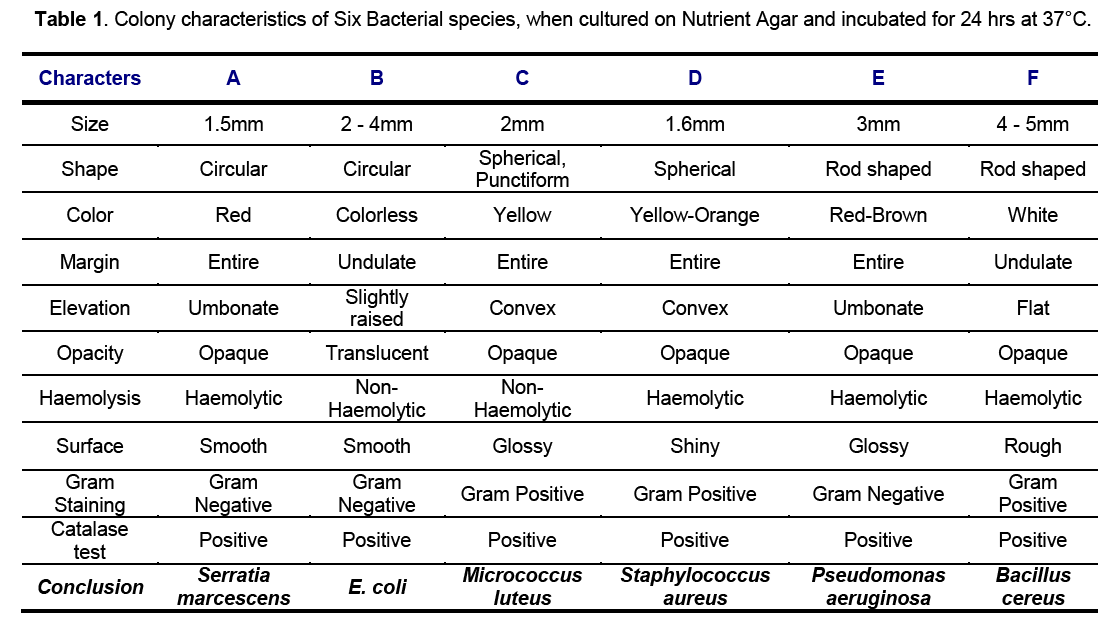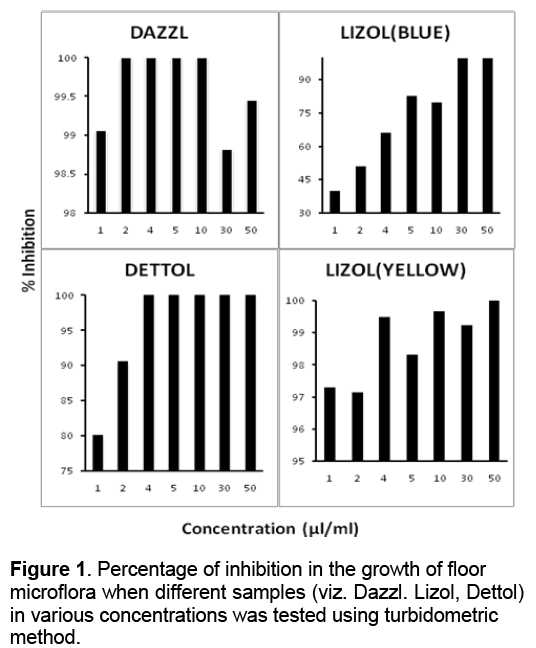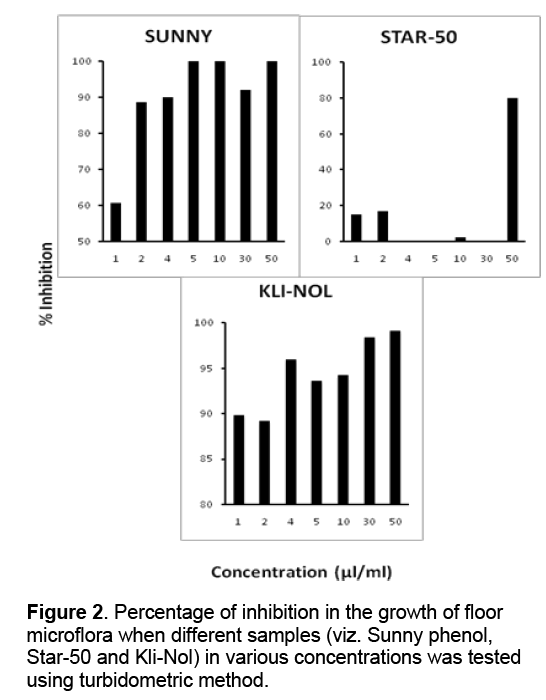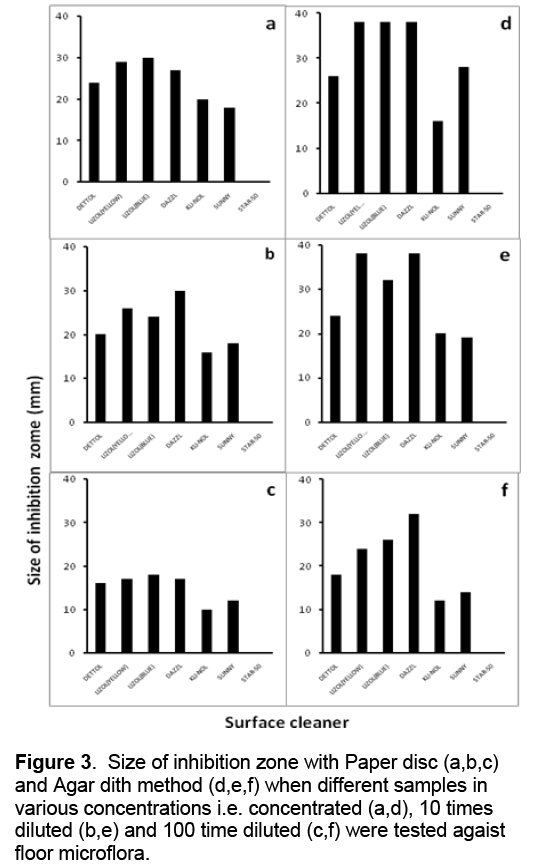Germ Invasion and a Comparative Analysis of Various Floor Cleaners
Sinha Atunu, Rai Shalini, Dasani Sonal
Department of Life Sciences, Kishinchand Chellaram College, D.W Road, Churchgate, Mumbai-400 020, India
- Corresponding Author:
- Tel: +919820291092
E-mail: sonaldasani@yahoo.com
Abstract
Microorganisms, the friend and foe of human being are omnipresent in and around us. Innumerable pathogenic and non pathogenic microorganisms remain present on the floor surface with which we are in direct physical contact. These organisms include Salmonella, Rhinovirus, Herpes, Trichophyton, Giardia, E. coli, Micrococcus species etc. Most of the microbes are non pathogenic when present in less quantity, but as their concentration increases they are able to cause various diseases like Stomach upsets, diarrhoea, Cold, Cold sores etc. To restrict the growth of such microbes in the surroundings including floors, various commercially available floor cleaners such as Phenyls, Dettol, Kli-Nol, Dazzl, etc. are used. Present study is an attempt to isolate and identify the floor micro flora from home and laboratory and to observe the efficacy of different floor cleaners. According to Indian Medical Association (IMA) “Dettol and Lizol” are identified as the most effective disinfectant against the floor micro flora, and therefore they are considered as standards to analyze effectiveness of other commercial surface cleaners. Our study suggested that Dazzl can inhibit the growth of common floor micro flora as effectively as Dettol and better than Lizol.
Keywords
Agar Ditch method, Disinfectants, Paper Disc method, Pathogenic microbes, Surface cleaners, Turbidometric method (Turbidometry).
1. Introduction
Microorganisms, particularly bacteria are ubiquitous and are found in all the places including hot environments of deep sea, sulphur vents, frozen tundra of the Antarctic, saline environment of the Dead Sea and extremely acidic environments such as stomach of humans [1]. Bacteria can be pathogenic like Salmonella, responsible for variety of diseases or non-pathogenic like E. coli, that can act as opportunistic organisms or even useful like Lactobacilli [2,3]. Though human being has very well developed immune system yet cannot get rid of all the foreign microorganisms. Many of the microorganisms are pathogenic only in higher concentration and are the causatives of most common diseases. Lots of these organisms inhabit the floor and can easily enter human body [4]. Disinfectants as surface cleaners are generally used to minimize the growth of these microbes on the floor to avoid infections and diseases. Disinfectants are present in commercially available surface cleaners and are responsible for their effectiveness to fight against microbes [5]. Disinfectants are grouped into different categories i.e. Phenol and its derivatives, halogens, organic acid, quaternary ammonium compounds etc and one or more of them are present in the surface cleaners available in the market [6].
Various types of surface cleaners are used in maximum quantity to clean bathrooms and floors of homes, hospitals, laboratories etc. Ordinary Surface cleaners and Phenyls make the floors look clean but cannot disinfect them completely. Some phenyls disinfect the floor to certain levels but leave unpleasant odour. Infect, even after regular use of phenyls and surface cleaners, there may be presence of pathogenic micro organisms in high number [6]. Many different studies have also shown that long term exposure to phenyl compounds can have serious health consequences [7]. Indian Medical Association recommends Lizol as the most trusted disinfectant because it is easy to use and completely safe for family’s health. According to the policies of Indian Medical Association a good disinfectant should be capable of killing the germs by 99.99% within 60 seconds of exposure.
There are number of floor cleaners available in the market and a lay man always keep on experimenting with different brands; as new products constantly keeps on flooding in the market. There is an intense competition for the manufacturers of these products and they rely on advertisements to fascinate the customers for their survival up to a greater extent. A common man often tends to buy the products by getting convinced with better add-campaign rather than quality and composition of the product.
The present study is an attempt to compare the efficacy of various commercially available floor cleaners to reduce microbial growth. It will be of helpful to a lay man to understand the problem and choose the appropriate product available for use in homes, hospitals, laboratories etc.
With reference to above mentioned facts following objectives are set forth:
• Selection of various location to study floor micro flora
• Identification of most contaminated area in our surroundings
• Isolation of various types of microorganisms using floor samples
• Characterization of most abundant species by physical and biochemical examinations
• Selection of commonly used floor cleaner for the study by a basic survey
• Standardization of various methods to check the effectiveness of the floor disinfectants viz; Turbidometric method, Paper Disc method and Agar Ditch method
• Determination of optimum concentration of cleansers at which the growth of microbes is inhibited effectively
Sensitivity assay of micro flora against various disinfectants
2. Materials and Methods
Preparation of Inoculums
Three different areas of one square feet each from college laboratory and a well maintained home were marked and used for all the experiments. The marked areas were wiped with sterile cotton swabs of 2×2” and swabs were suspended in duplicates into 20 ml sterile saline. Every time the same process and places were used for the preparation of inoculums. The inoculums (100μl) was then inoculated in N-agar by surface spread in triplicates and incubated for 24 h at 37°C.
From many different types of colonies developed, six types were observed more frequently in all the samples. These colonies were further isolated by repeated streaking on N-Agar plates and identified using colony characters, Gram staining, haemolysis in blood agar plates and Biochemical test [8].
To check the efficacy of different floor cleaners (samples) against the floor micro flora following techniques were used:
• Turbidometric Method
The inoculums were inoculated to N- broth with different concentration of sample (1-50μl/ml). The tubes were incubated for 24 hrs at 37°C and optical densities were recorded at 540 nm. Each concentration of all the samples was analyzed in duplicate along with the controls and their mean is used to calculate % inhibition, which is plotted in the graph against concentration.
• Paper Disc Method
The inoculums (100μl) were spreaded uniformly in N-agar plates with the help of glass spreader and kept for five minutes. Pre- sterilized paper discs were dipped into different samples (surface cleaners) of various concentrations and placed in inoculated plates. The plates were incubated for 24 hrs at 37°C and size of clear zones developed surrounding each disc was measured by scale to the nearest mm and were plotted in the graph.
• Agar Ditch Method
With the help of cork borer four ditches were made per plate in the pre inoculated N-agar plates. Different surface cleaners in three different concentrations (i.e. undiluted, 10 times diluted and 100 times diluted), were added to these ditches (100μl) and plates were incubated at 37°C. After 24 hrs diameter of clear zone produced surrounding the ditches were measured to the nearest mm with the help of scale and were presented in the graph.
3. Results and Discussion
Various locations from the surroundings were selected for the preliminary examination of surface micro flora. That includes, bathrooms floors, toilet seat, taps, shower handles, telephone key pads, switch boards, kitchen top, sinks, dustbin and its holders, Remote controls, utensil storage racks etc. The areas with high humidity were found to more prone for growth of microorganisms like bathrooms, kitchen sink etc. Our results contradict with ‘Dettol & Lizol – Global Hygiene Survey’ which says that most germs can be found on surfaces such as light switches, telephone receivers and television remote controls [7]. It is practically impossible to keep any home free from microorganisms, but in order to create hygienic condition; the growth of microorganisms should be minimized by various means like flushing with water, cleaning etc.
Floors, particularly the grooves between two tiles are an ideal place for luxuriant growth of microorganism and bacteria can survive there for long period of time. Many times during the day, one is in direct contact with the floor of homes and laboratories, therefore, the floors of such places should be given more emphasis for maintaining hygienic conditions.
The present investigation aims at determining effectiveness of various commercially available floor cleaners and therefore, floor samples from the college laboratory and investigator’s home are selected for analysis. All the floor samples collected and inoculated to N-agar for the preliminary studies showed lots of bacterial growth. Amongst the various types of bacterial colonies obtained six most frequently occurring colonies were selected and identified.
Table 1 summarizes the colony characters of selected organisms.

Among the six bacterial species identified, Serratia marcescens, Staphylococcus aureus, Pseudomonas aeruginosa and Bacillus cereus showed haemolysis on blood agar plates and therefore are pathogenic [9].
The basic survey conducted considering 200 consumers revealed that commonly used floor cleaners includes Phenyl, Lizol, Dettol, Domex, Dazzl, Kli-Nol and some more local products. Considering it in the mind Kli-Nol, Sunny Phenyl, Star-50 phenyl, Lizol blue and its modified product Lizol yellow, Dazzl and Dettol were selected for analysis.
There are three methods generally used for microbial sensitivity assay includes Paper disk, Agar ditch and Turbidometric analysis [2,10]. All these methods have several advantages and disadvantages and therefore, yield different results with varying nature of samples. In the present study all of these methods were used to find out suitable technique for similar kind of microbial assays.
Figure 1 represents percentage of inhibition in the growth of floor micro flora when different samples (viz. Dazzl. Lizol, Dettol) in various concentrations was tested using turbidometric method. From the graph it is clear that Dazzl showed maximum inhibition in growth even at low concentration (2μl/ml), followed by Dettol, Lizol yellow and Lizol blue.
In case of Sunny phenyl, Kli-Nol and Star 50, % Inhibition was increasing with increase in concentration, but Star-50 phenyl showed very less Inhibition until used in higher concentration (50μl/ml, Figure 2).
In general, Dettol and Dazzl were found to be most effective Floor cleaners. Dettol and Dazzl had shown maximum inhibition at less concentration (2-4μl/ml). Lizol (Blue and Yellow) was less effective as compared to Dettol and Dazzl in inhibiting the growth of microbes. Star-50 phenyl had shown least inhibition as compared to other disinfectant used for this study (Figure 1, 2).
To study the relative effectiveness of various samples studied, Analysis of variance (ANOVA) was performed. Difference in % inhibition demonstrated by various samples was statistically highly significant (P<0.001). However, out of all the cleansers used, Lizol and Dazzl are found to be most effective along with the disinfectant Dettol. When inhibition caused by Dettol and Dazzl were compared using two tailed paired t-test, it showed non-significant difference, where as Lizol and Dazzl showed significant difference at P< 0.05, suggesting that Dazzl is more effective than Lizol and as effective as Dettol. However, Lizol yellow is working out to be a better inhibitor of microbial growth as compared to Lizol blue.
The samples (concentrated, 10 times diluted and 100 times diluted) were used for Paper Disc and Agar Ditch method. The results are similar to that of turbidometric method, where Dazzl and Lizol (Blue and Yellow) were found to be the most effective floor cleaners for inhibiting growth of microbes along with the Dettol (Figure 3). Single factor ANOVA performed amongst various floor cleansers considering size of inhibition zone as parameter showed statistically significant difference (P<0.01). However, Dzzal and Lizol demonstrated non significant difference in their effectiveness against floor micro flora. Paper disc and agar ditch method produced the same results for all the samples.
4 Conclusions
The present investigation suggests that unhygienic places supported by moisture content facilitated maximum microbial growth. Out of many microbial species observed on Nutrient agar plates, Serratia marcescens, E. coli, Micrococcus luteus, Staphylococcus aureus, Pseudomonas aeruginosa and Bacillus cereus were the most frequent. Among the six bacterial species identified, Serratia marcescens, Staphylococcus aureus, Pseudomonas aeruginosa and Bacillus cereus were found out to be pathogenic. Lizol and Dettol are surface cleaners recommended by Indian Medical Association, but from the present study it was noted that Dazzl showed maximum antimicrobial activity amongst the various floor cleaners tested by three different techniques. All the methods used in the present study were found to equally effective and sensitive for the present analysis
References
- Sherwood L.M., Willey J.M., Woolverton C.J. (2008) Microbial Evolution, Taxonomy and Diversity, Prescott, Harley and Kleins Microbiology – Seventh Edition, New-York, McGraw Hill Companies, pp. 497-500. [2] Pelczar M.J., Chan E.C.S., Kreig N.R. (2000) Microbiology - Fifth Edition, New- York, Tata Mac Graw Hill Publishing Co. Ltd, pp.137-386.
- www.textbookofbacteriology.net [4] Case C.L., Funke B.R., Tortora G.J. (2008) Innate Immunity, Microbiology - Ninth Edition, South Asia, Pearson Education, pp. 474-476
- Ascanzi J.M. (1996) Glutaraldehyde based Disinfectants, IN: Handbook of Disinfectants. Ascezzi, J.M (Ed.), New-York: Marcel Dekker Inc, pp. 111-132.
- https://en.wikipedia.org/wiki/disinfection
- www.lizol.co.in [8] Kanan N. (2003) Handbook of Laboratory, Culture Media, Reagents, Stains and Buffers, New-Delhi, Panami Publishing Corp., pp. 33-104. [9] Daftary V.G., Banker D.D., Daftary G.V. (1996) Clinical Microbiology, First Print, Bombay, Universal Publishing Corporation, pp. 12-55.
- Bhatt K.R., Gokani S.J, Bagatharia B.S., et al. (2003) Antimicrobial activity of some medicinal plants, Asian Journal of Microbiology Biotechnology and Environmental Sciences. 5(4): 455-462.

Open Access Journals
- Aquaculture & Veterinary Science
- Chemistry & Chemical Sciences
- Clinical Sciences
- Engineering
- General Science
- Genetics & Molecular Biology
- Health Care & Nursing
- Immunology & Microbiology
- Materials Science
- Mathematics & Physics
- Medical Sciences
- Neurology & Psychiatry
- Oncology & Cancer Science
- Pharmaceutical Sciences



